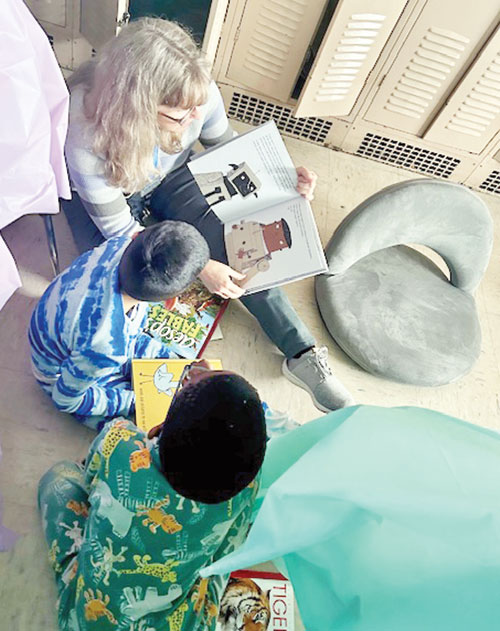One school’s stunning surge in student literacy reflects the archdiocese’s overall success

Pam Breedlove, a literacy coach at Central Catholic School in Indianapolis, reads to third-grade students during Camp Read A Lot, a celebration of the school’s dramatic improvement in student literacy, with a 51.7 percentage-point increase in its Indiana Reading Evaluation and Determination (IREAD) testing in the 2024-25 school year. (Submitted photo)
By John Shaughnessy
When Tami Clouse received the invitation from the Indiana Board of Education to share the remarkable story of what happened at Central Catholic School in Indianapolis, she became emotional, viewing the honor as a celebration of “a beautiful community.”
In just one year, the school made a dramatic improvement in student literacy, with a
51.7 percentage-point increase in its Indiana Reading Evaluation and Determination (IREAD) testing. The school’s pass rate among its third-grade students improved from 48.3% in the 2023-24 school year to 100% in 2024-25.
“The celebrations that we have had at my school with the children are phenomenal,” said Clouse, the school’s principal, during her presentation to the state’s board of education on August 13. “So, we are very excited about that. Makes me a little emotional.”
That success at Central Catholic, one of the archdiocese’s three Mother Theodore Catholic Academies, also reflects the overall success of the 55 Catholic elementary schools in the archdiocese regarding IREAD.
Combined, archdiocesan elementary schools achieved a 93% total pass rate compared to the state average of 87.3%, according to Sarah Watson, assistant superintendent of elementary education in the archdiocese.
Watson also noted that 23 of the
55 schools had a pass rate of 100% while six more schools surpassed the 90% rate. At the same time, she added, 82% of second-grade students in the archdiocese passed the literacy test and won’t have to take it again.
The success of the Catholic grade schools drew high praise from Brian Disney, superintendent of Catholic schools in the archdiocese.
“We are very happy for the success our Catholic school students had on IREAD,” Disney said. “Our students, schools and families deserve credit for their efforts to ensure all students can read by the end of third grade. Some students need additional supports and time, which our schools provided. The parent-school partnership was essential for our success.”
Watson also noted that the Catholic schools’ success in the past year reflected “a clear plan at the archdiocesan, state and local levels, and the daily fidelity of teachers to practices that work.”
“In our Catholic schools, that plan meets our mission,” she said. “We want children to read with confidence because we are preparing them for life and for heaven. Literacy opens minds to truth and hearts to beauty, and our schools take that charge seriously.
“What is most encouraging is that gains reached students across the board. Black and Latino students grew. Students with disabilities grew. English learners grew. Students from low-income households grew,” Watson noted. “That breadth tells us the strategy is working for all of God’s children, not only for some.”
Statewide statistics showed that Black students, Hispanic students and students in special education all achieved a
7.5% increase in student literacy in the past school year, while English-language learners improved at a 7.2% rate.
That achievement reflects both the success and diversity at Central Catholic School. In her presentation to the state board of education, Clouse noted that the school serves 239 students from across Indianapolis, with 97% of the children identifying as “Hispanic, multi-cultural, multi-racial or Black.”
“They represent 11 countries across the world,” she said. “At home, they speak English, Spanish and Swahili.”
The third-grade students were rewarded for their success during a celebration at the school called Camp Read A Lot.
“The kids and adults had a blast celebrating,” Clouse said. “Desks were covered with table clothes to make a ‘tent’ for each student to read under. Students were invited to wear their pajamas and slippers for this celebration. Each student was allowed to pick out a new book and a Beanie Baby. These were a donation to our school. This was a great way to celebrate the third-grade growth.”
Clouse credits the success at Central Catholic to several factors, factors that Watson also credits for the overall success of Catholic schools in the archdiocese.
Schools tapped into approaches that include tutoring, after school labs and family involvement, as well as skilled coaches, earlier and more frequent assessment, and curriculum that focused on the science of reading.
The cooperation of parents is always a key, they both note.
“We really had to think differently about how we connected with parents,” Clouse said, concerning the diversity of the parents whose children attend Central Catholic. “The biggest shift for us was helping them see that reading is reading—no matter the language. Our parents are fully capable of supporting their kids, and that realization built confidence and trust on all sides.”
Watson praised the overall collaboration that led to the success achieved at Central Catholic.
“Central Catholic stands out as a witness to what is possible when mission meets method,” Watson said. “Tami and her team set a culture where every minute of instruction counts, families are true partners, and children are known by name and loved. The academic results are impressive. The deeper story is formation. Students are growing in confidence, perseverance and joy.”
That same goal is being achieved in Catholic schools across central and southern Indiana, she said.
“In the archdiocese, we have seen what happens when parishes, community partners and schools pull together. Families leaned in, teachers stayed the course, and students felt the support around them.” †
